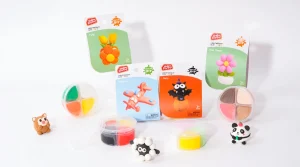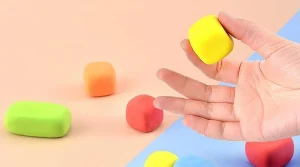
What Is the Difference Between Montessori Toys and Normal Toys?
Montessori vs. normal toys: explore how design, purpose, and learning goals shape children’s play and development in meaningful ways.
#1 Toys Manufacturer in China. WhatsApp: +86 180-0088-4063. Email: [email protected]
#1 Toys Manufacturer in China. WhatsApp: +86 180-0088-4063. Email: [email protected]

Modeling clay is a soft, moldable material used by children to shape and create figures, objects, or simple structures. It doesn’t dry out quickly, allowing repeated play. Most types are non-edible, though often labeled as non-toxic. While it may look like playdough, modeling clay is not meant for very young children unless clearly marked safe for their age.
Modeling clay refers to any pliable substance made for shaping by hand. It’s used in art, school projects, and play. Kids often use it to build animals, vehicles, or letters. Some clays harden over time, while others stay soft. The purpose is not just fun—it also helps build fine motor skills and coordination.
Not all modeling clay is the same. Different types are made with different ingredients. Some are better for classroom use. Others may be unsafe for younger children or kids with skin issues. It’s important to know what kind of clay is in use before handing it to a child.
Oil-Based Clay
Oil-based modeling clay stays soft and never dries out. It’s made with waxes or oils that keep the texture smooth. Because of this, it’s great for reuse, but it can leave greasy marks on hands or furniture. Kids might like how easy it is to shape, but it’s not ideal for baking or long-term projects.
For example, Jamie, age 9, once used oil-based clay to build a small zoo. By the end of the day, the models were intact, but her shirt had oil spots that didn’t wash out.
Polymer Clay
Polymer clay is made from PVC, a type of plastic. It feels like regular clay but must be baked in an oven to harden. That’s where safety concerns come in. Heating PVC can release fumes, especially if done at the wrong temperature. The American Lung Association warns that overheating plastics may emit harmful substances (ALA, 2023).
So while polymer clay is common in arts and crafts, it’s better suited for older kids under adult supervision. It’s not recommended for preschool classrooms or young kids’ unsupervised play.
Air Dry Clay (e.g., PVA-based)
Air dry clay is often made from lightweight materials like PVA (polyvinyl alcohol). It hardens without heat, simply by being left out in the air. PVA is water-soluble and commonly used in school glue, making this type of clay gentle on skin and easy to clean up.
For children, especially those under 8, PVA-based air dry clay is a safer alternative. It’s soft, smooth, and does not require a kiln or oven. Plus, if some sticks to a desk or table, warm water usually does the trick. This makes it a more classroom-friendly option.
Not all modeling clays are made the same. Some are plant-based, others synthetic. Knowing the ingredients can help you decide which type is safe for your child’s hands—and health.
Natural clays often use ingredients like flour, salt, and water. These are generally safer and easier to wash off. On the other hand, synthetic clays may include plasticizers, mineral oils, and pigments that can irritate sensitive skin.
For example, a preschool once used homemade flour-based clay for art time. A few students got it in their mouths—but no harm was done. When they switched to a store-bought clay with added polymers, one child developed mild skin redness. It’s a small reminder: simple is often safer.
Some modeling clays use additives to make them last longer or feel softer. These might include parabens, synthetic dyes, or PVC-based plastics. While most are labeled non-toxic, that doesn’t mean they’re risk-free for all kids.
Fragrances can be a hidden issue. A strong scent might be fun at first—but could trigger headaches or allergic reactions. Always check labels, especially for kids with asthma or eczema.
Air dry clay made with PVA (polyvinyl alcohol) is water-based and non-toxic. PVA is also found in school glue, so it’s already considered safe for children. This type of clay dries naturally in open air, with no need for heat or harsh chemicals.
Unlike oil-based or polymer clays, PVA clays don’t contain heavy plasticizers. That means fewer fumes, less residue, and reduced skin risk. It’s soft, smooth, and a smart pick for classrooms or first-time sculptors.
>> How to Choose a Reliable Air Dry Clay Manufacturer
Modeling clay can be fun at any age—but safety depends on how it’s used and what it’s made of. Different age groups need different levels of care.
Young kids may treat clay like a snack, so always watch closely. Even non-toxic types can be a choking hazard. Supervision also helps avoid messes and keeps clay away from eyes or broken skin.
Older children might not need constant watching, but it’s still smart to guide them—especially when handling tools, sharp molds, or unfamiliar brands.
Yes, kids sometimes eat clay. Whether it’s curiosity or just a quick lick, it happens more often than you’d think. But is it dangerous?
Even soft clay can be a choking hazard. Small balls or pieces might get stuck in the throat. That’s why labels like “non-toxic” don’t mean “edible.” They simply mean the material shouldn’t cause poisoning if a small amount is swallowed.
Parents should always read the packaging and look for safety certifications (like ASTM D-4236 in the U.S.).
First, stay calm. If your child eats a small piece of clay labeled non-toxic, they’ll likely be fine. Offer water and watch for signs of upset stomach.
If the clay is not labeled non-toxic, or if your child has swallowed a large amount, contact poison control or your pediatrician immediately.
If choking is suspected—such as coughing, gagging, or trouble breathing—seek emergency help without delay.
Most kids use their hands to shape, pinch, roll, and squish modeling clay. That’s part of the fun! But what about children with sensitive skin? Let’s take a closer look.
Some modeling clays may contain preservatives, dyes, or perfumes that can irritate the skin—especially in children with eczema, allergies, or general sensitivity. Symptoms might include redness, itchiness, or even small rashes after prolonged use.
A child with a history of contact dermatitis, for example, might react to a fragranced clay that doesn’t bother others. That doesn’t mean clay is off-limits—it just means choosing the right type matters.
For children prone to skin irritation, clays made from water-based materials—like PVA air dry clay—are typically safer. They’re smoother, less sticky, and free from many harsh additives.
These clays don’t need baking or sealing, which means no additional chemicals are introduced during play. Always remind kids to wash hands after crafting, even with gentle formulas.
Indoor air quality matters—especially in classrooms or small playrooms. Some modeling clays give off a distinct smell, while others stay odorless. So what’s safe?
Polymer clays are made with PVC and must be baked to harden. During baking, they may release VOCs (volatile organic compounds) into the air. These fumes aren’t always visible but can irritate the nose, throat, or lungs—especially in sensitive children.
It’s best to avoid baking polymer clay in a shared kitchen oven. If it must be used, good ventilation is key.
Air dry clay made with PVA (polyvinyl alcohol) contains no VOCs and does not require baking, making it a safer option for homes, schools, and indoor play centers.
It’s practically odorless and dries naturally in the open air. That means fewer smells and less stress for parents, teachers, and kids alike.
A few smart practices can make clay time both creative and safe—whether it’s at the kitchen table or an art room full of little hands.
Even preschoolers can learn good clay habits. Show them how to:
It’s all about building fun routines that protect everyone.
For kids with respiratory issues or chronic skin conditions, playtime can be tricky. Let’s talk about what to avoid—and what works better.
Even if labeled non-toxic, these ingredients may still trigger flare-ups in sensitive children.
Air dry clay made from PVA is gentle, smooth, and less likely to cause skin or breathing reactions. It contains fewer additives, making it a go-to material for art therapy and special education classrooms.
Still, it’s a good idea to patch test any new clay on a small area of skin first—especially for kids with a history of eczema or allergies.
There’s a growing shift toward safer, more natural materials in children’s products—including modeling clay. But what does “non-toxic” really mean?
A “non-toxic” label means the product won’t cause poisoning if used as intended or accidentally ingested in small amounts. It doesn’t guarantee it’s free from all harmful reactions—especially for sensitive users.
Always look for clays that pass safety standards like ASTM D-4236 (USA) or EN71 (EU), and still read the ingredient list carefully.
PVA-based air dry clays are not only safer for kids—they’re also more environmentally conscious. Many formulas use fewer chemicals, require no heat, and come in recyclable packaging.
That means cleaner play for children today—and a lighter impact on the world they’ll inherit.
Modeling clay can be safe for kids when age-appropriate, non-toxic options—like PVA-based air dry clay—are used responsibly. With proper supervision, hygiene, and smart material choices, children can enjoy creative play without unnecessary health risks.
>> What Is the Best Air Dry Clay for Beginners? A Friendly Guide
Yes, many types of modeling clay—especially air dry and water-based clays—can dry out when exposed to air for too long. Always store it in an airtight container or resealable bag to keep it soft and reusable. For long-term use, check storage instructions on the package to avoid waste and hardening.
Most modeling clays are not microwave-safe. Heating them this way may release fumes, cause burns, or lead to uneven hardening. Air dry clay should dry naturally, while polymer clay is typically baked in a conventional oven at specific temperatures. Always follow manufacturer instructions instead of improvising drying methods.
Yes, many modeling clays can be blended to create custom colors. Kneading two or more colors together gradually forms a uniform shade. However, results vary based on clay type—some blend easily, while others may resist mixing due to different bases or ingredients. It’s a fun way for kids to experiment with color theory through hands-on play.
Modeling clay can last months or even years depending on the type and how it’s stored. Air dry clay may harden over time, while oil-based or polymer clays often remain pliable longer. To extend shelf life, keep clay in a cool, dry place away from direct sunlight and make sure it’s sealed properly after each use.
Yes, modeling clay can be shaped and applied to surfaces like wood, cardboard, or glass during craft projects. However, it may not stick permanently without adhesives or surface prep. Some types can stain porous materials like fabric or untreated wood, so it’s best to use a barrier layer (like parchment paper) or test on a small area first.
More Related...

Montessori vs. normal toys: explore how design, purpose, and learning goals shape children’s play and development in meaningful ways.

Explore the truth about air dry clay and water—why it softens, what to avoid, and how to care for your crafts.

Learn the science behind modelling clay: its ingredients, types, safety, and how it compares with playdough and air dry clay.

Wondering which clay is best for clay modelling for kids? Explore air dry clay, playdough, and more in this simple educational guide.

Our team will answer your inquiries within 48 hours.
Copyright © 2025 GuangDong AKIA Technology Co,. Ltd. All Rights Reserved